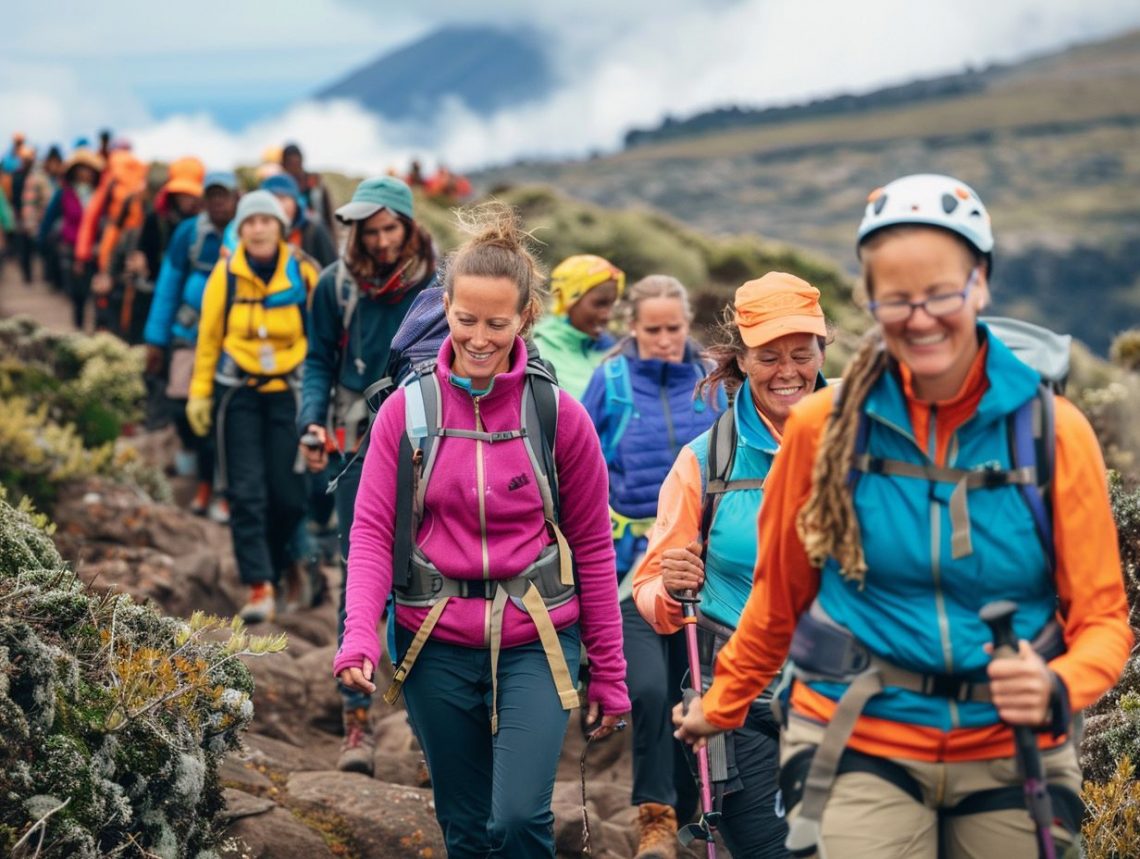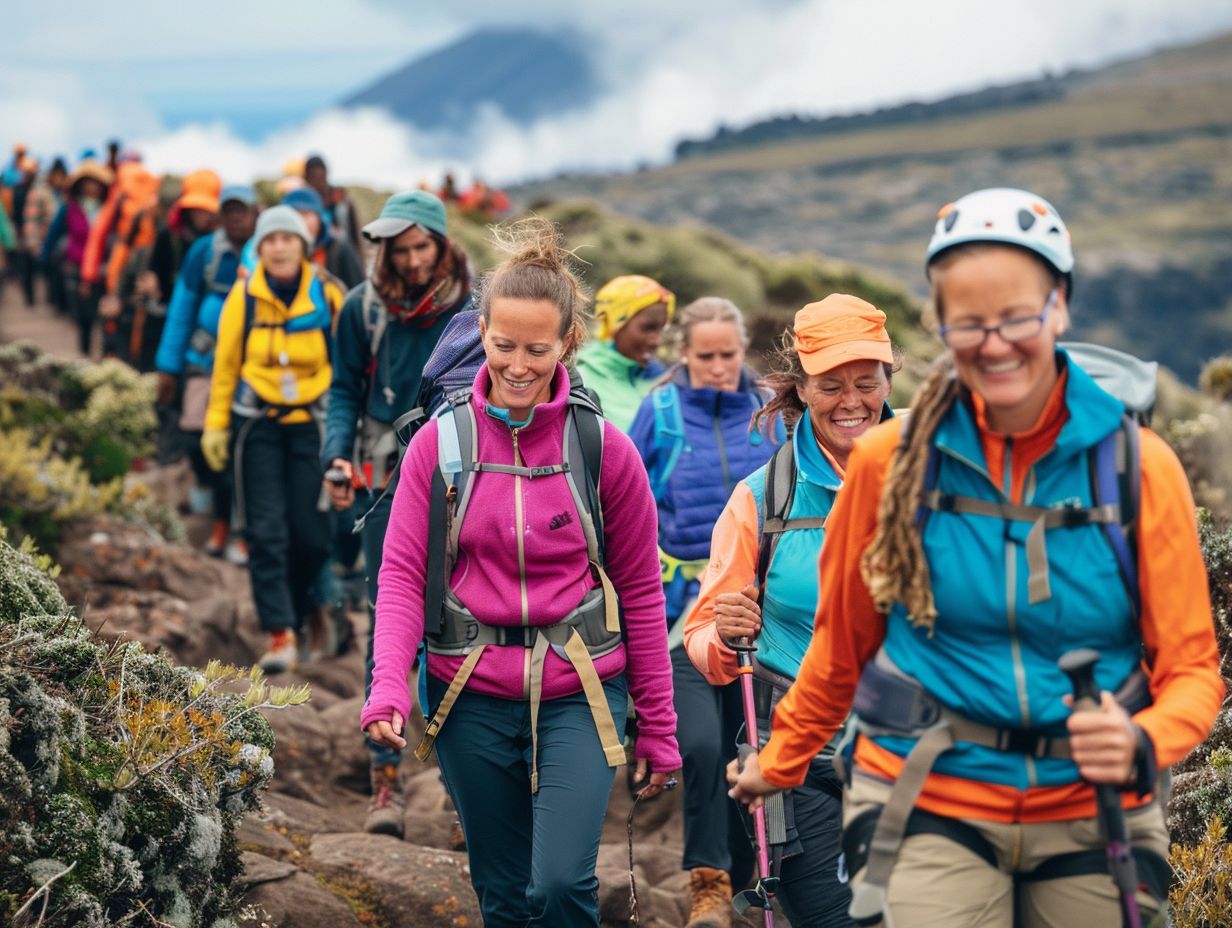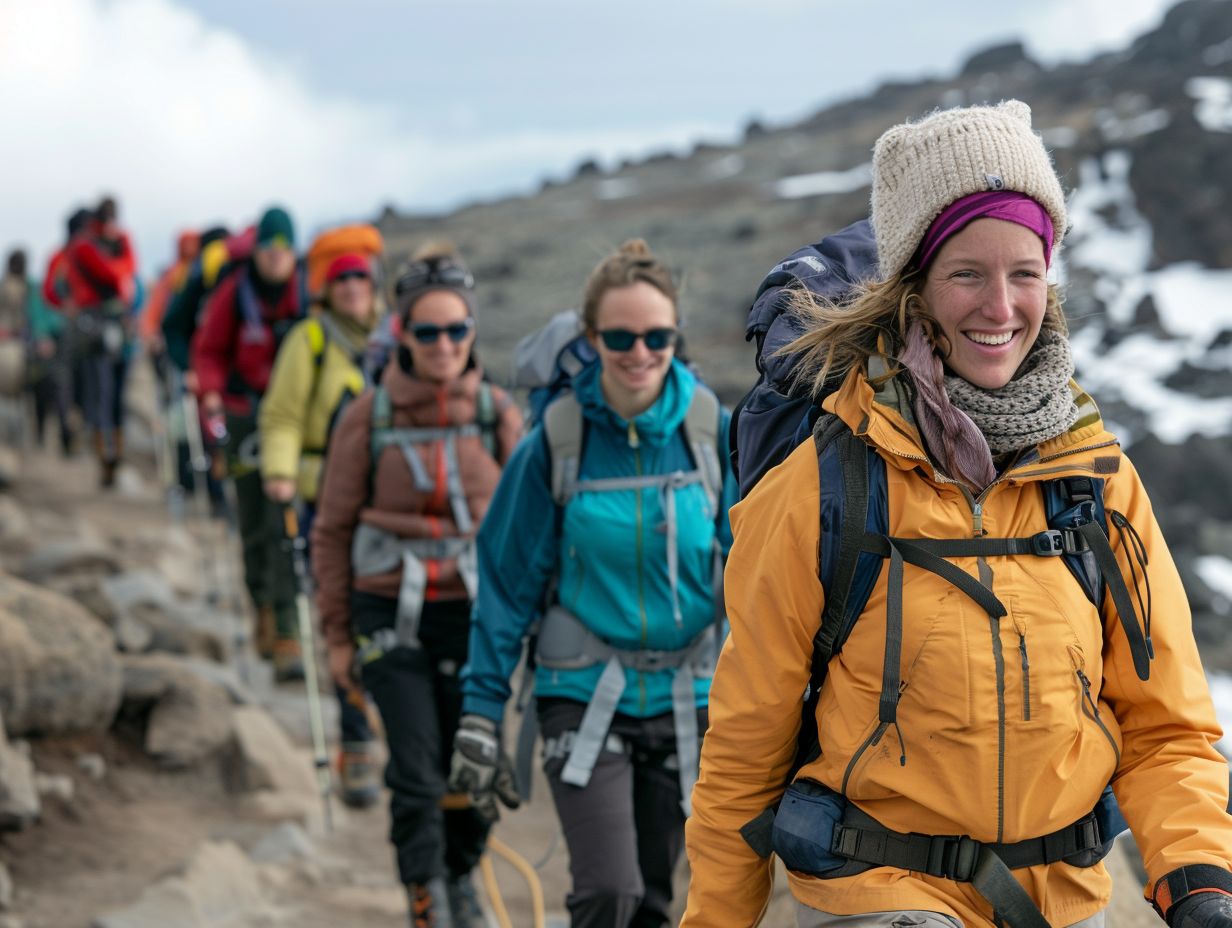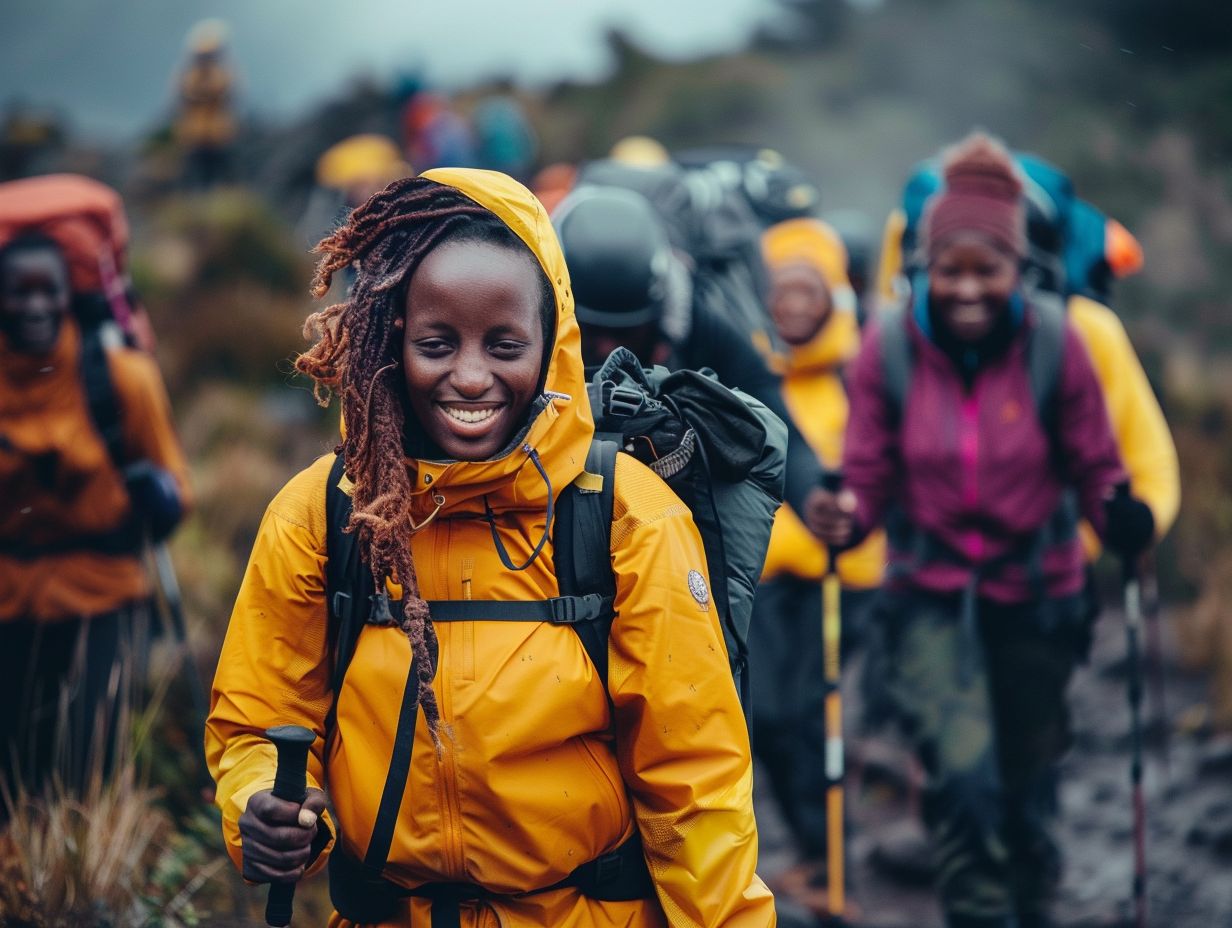
Tips For Women Climbing Kilimanjaro
Are you planning to conquer Mount Kilimanjaro? Whether you are a seasoned climber or a beginner, preparation is key to a successful climb.
In this comprehensive guide, we will cover everything from physical and mental preparation to what to pack for the climb.
We will also provide tips for training effectively and ensuring a safe climb, especially for women.
So lace up your hiking boots and get ready for the adventure of a lifetime!
Key Takeaways:

- Proper preparation, both physically and mentally, is crucial for a successful climb up Kilimanjaro.
- Packing the right clothing, gear, and personal items is essential for comfort and safety during the climb.
- Women should prioritize cardiovascular, strength, and endurance training before attempting to climb Kilimanjaro.
Preparing for the Climb
Preparing for a Kilimanjaro climb involves thorough physical and mental preparation due to the challenging altitude and terrain. It is essential to equip yourself with the right gear and training to ensure a safe and successful expedition.
1. Physical Preparation
Physical preparation for climbing Kilimanjaro is crucial to build endurance and acclimatize your body to high altitudes. Training regularly with a focus on cardiovascular and strength exercises will enhance your fitness levels.
Cardiovascular exercises such as hiking, running, cycling, and swimming help improve your heart and lung efficiency, essential for high-altitude trekking.
Incorporating strength training activities like weightlifting, bodyweight exercises, and yoga can strengthen muscles and joints, aiding in carrying heavy loads during your climb.
To further boost your endurance, consider endurance-building activities such as long hikes, stair climbing, and interval training to simulate the conditions you’ll face during the ascent of Kilimanjaro.
2. Mental Preparation
Mental preparation is equally important for a Kilimanjaro climb. Visualizing success, staying positive, and mentally preparing for challenges will help you overcome obstacles during the expedition.
Visualizing success involves creating a mental image of reaching the summit, feeling the excitement of achievement, and conquering any doubts.
Cultivating a positive mindset is crucial as it builds resilience and determination to face the physical and mental demands of the climb.
It’s essential to prepare for potential mental hurdles by developing strategies like focusing on one step at a time, using affirmations, and practicing mindfulness to stay present in challenging situations.
What to Pack for the Climb
Packing appropriately for a Kilimanjaro climb involves selecting the right clothing, gear, and equipment to ensure comfort, safety, and performance throughout the trek.
1. Clothing
Choosing the appropriate clothing for a Kilimanjaro climb is key to staying comfortable and protected against changing weather conditions. Thermal gear and layering are essential for maintaining body heat at higher altitudes.
When braving the elements on Mount Kilimanjaro, it’s crucial to prioritize functionality over fashion. Waterproof and windproof outer layers are fundamental to shield against rain, snow, and strong winds.
Insulated jackets, such as down or synthetic options, provide warmth without adding bulk. Merino wool base layers and socks are excellent for moisture-wicking and temperature regulation.
Consider the diverse climate zones of Kilimanjaro, ranging from tropical at the base to Arctic-like conditions near the summit.
Adaptable clothing choices, such as convertible pants and zip-off layers, allow for easy adjustment as temperatures fluctuate. Don’t forget a reliable pair of gloves and a hat to protect extremities from frostbite.
2. Gear and Equipment

Having the right gear and equipment is crucial for a successful Kilimanjaro climb. Items such as trekking poles, hydration salts, and appropriate footwear are essential for the trek.
Other essential gear and equipment include insulated clothing, a durable backpack, a headlamp, and a reliable compass. It’s also crucial to bring a high-quality sleeping bag and a tent suitable for camping in various weather conditions.
- Waterproof and windproof outerwear is a must to protect against changing weather on the mountain.
- Proper hydration solutions, such as a hydration bladder or water bottles, are essential for staying hydrated during the trek.
- Carrying nutrition-rich snacks and meals is necessary to maintain energy levels throughout the climb.
3. Toiletries and Personal Items
Packing toiletries and personal items for a Kilimanjaro climb requires considerations for hygiene, safety, and special needs such as menstrual products.
Items like she-wee and diva cups can be beneficial for female climbers. It’s crucial to pack items that promote hygiene and comfort during the challenging ascent.
Along with the aforementioned products, antibacterial wipes, toothpaste, and a small hand sanitizer are essential.
- Antiperspirant or deodorant can help freshen up during the journey.
- Sunscreen and lip balm with SPF to protect against the high-altitude sun exposure.
- Moleskin or blister treatment for foot care in case of discomfort.
Remember to bring along a small first aid kit for minor injuries or ailments that may arise. Creating a personalized toiletry kit tailored to your needs ensures a smoother and more comfortable climb.
Training for the Climb
Training for a Kilimanjaro climb is essential to build the necessary fitness, endurance, and stamina required to tackle the challenging trek. A combination of cardiovascular, strength, and endurance training is recommended.
1. Cardiovascular Training
Cardiovascular training plays a vital role in preparing for a Kilimanjaro climb as it enhances overall fitness, endurance, and cardiovascular health. Regular cardio workouts will improve your stamina for the trek.
To effectively train your cardiovascular system for the demanding Kilimanjaro ascent, it’s essential to incorporate exercises that elevate your heart rate and strengthen your heart and lungs.
Activities such as running, cycling, hiking, and stair climbing are excellent choices.
Interval training can be particularly beneficial for mimicking the varying intensities you’ll face on the mountain. It involves alternating between high-intensity bursts and recovery periods.
When structuring your training program, aim for at least 3-4 sessions per week, gradually increasing the duration and intensity as your fitness improves.
Consistency is key to building the necessary cardiovascular endurance for the challenging conditions of Kilimanjaro.
2. Strength Training
Strength training is essential for Kilimanjaro climbers to build muscle strength, improve stability, and reduce injury risks during the trek, enhancing overall physical preparedness.
When training, focus on exercises that target the major muscle groups utilized in trekking, such as legs, core, and back. Squats, lunges, deadlifts, and planks are excellent choices.
Using resistance bands or weights can add intensity to your workouts. Proper gear is also crucial for safe and effective training. Invest in supportive footwear, breathable clothing, and consider adding trekking poles to simulate mountain conditions.
Remember to warm up before each session and cool down afterward to prevent muscle strain.
3. Endurance Training
Endurance training is crucial for Kilimanjaro climbers to improve stamina, mental resilience, and the ability to endure long hours of trekking. Engaging in endurance activities will prepare you for the challenges of the climb.
Hiking on varied terrain is key for Kilimanjaro climbers, building leg muscles and cardiovascular endurance to prepare for the ascent.
Plus hiking, incorporating running, cycling, and stair climbing into your training regimen can further enhance your cardiovascular fitness and stamina.
Training strategies should focus on gradual progression to avoid injury and build endurance over time. Mental preparedness techniques can help climbers stay focused and motivated during the grueling trek.
Tips for a Successful Climb

To ensure a successful Kilimanjaro climb, it’s essential to pace yourself, stay hydrated, and maintain a positive mindset throughout the journey. Taking breaks when needed and listening to your body are vital for a safe and enjoyable expedition.
1. Pace Yourself
Maintaining a steady pace is key to conserving energy and avoiding exhaustion during a Kilimanjaro climb. Pace yourself according to your fitness level and the demands of the terrain to ensure a sustainable ascent.
Tips to pace yourself:
- Setting a manageable rhythm from the start can prevent burnout and improve overall performance.
- Focus on taking regular breaks to catch your breath and refuel with snacks to maintain stamina.
- Hydration plays a crucial role in altitude acclimatization, so drink steadily to combat dehydration.
- Safety should always be a priority, so familiarize yourself with emergency procedures and equip yourself with the necessary gear, including layers for changing weather conditions.
- Mental resilience is vital; cultivate a positive mindset and embrace the challenges as part of the adventure.
2. Stay Hydrated
Staying hydrated is crucial for Kilimanjaro climbers to maintain energy levels, prevent altitude-related illnesses, and ensure overall well-being during the trek. Carrying sufficient water and using hydration gear is essential.
Few hydration tips:
- Sip water frequently throughout the hike rather than waiting until feeling thirsty.
- Using electrolyte tablets or sports drinks can help replenish lost minerals and salts due to sweating.
- Wearing a hydration pack or belt can make it easier to drink on the go without disrupting the pace.
- It’s advisable to set a daily water intake goal and monitor urine color to ensure proper hydration levels.
3. Take Breaks When Needed
It’s important to listen to your body and take breaks when needed during a Kilimanjaro climb to rest, refuel, and prevent exhaustion. Breaks allow you to recharge and maintain focus on reaching the summit.
Taking breaks while ascending Mount Kilimanjaro is crucial for climbers to optimize their physical and mental well-being.
Properly timed rest periods not only aid in avoiding burnout but also play a vital role in acclimatization. Strategies for effective breaks include scheduling intermittent stops to hydrate, snack on energy-rich foods, adjust gear, and catch your breath.
Plus physical benefits, breaks also offer climbers a chance to appreciate the stunning surroundings, fostering a sense of enjoyment and motivation during the challenging ascent.
4. Listen to Your Body
Listening to your body is crucial during a Kilimanjaro climb to recognize signs of fatigue, altitude sickness, or discomfort. Being attuned to your body’s signals allows you to take necessary precautions and ensure a safe ascent.
Being aware of your physical limits and mental well-being can make all the difference in a challenging trek like Kilimanjaro. It’s not just about the physical hurdles; psychological preparedness is equally essential.
Self-monitoring of breathing, heart rate, and hydration prevents issues. Support from fellow climbers or guides aids in navigating terrain and offering encouragement.
5. Use Trekking Poles
Trekking poles on Kilimanjaro provide stability, joint relief, and balance on diverse terrains, enhancing safety and endurance.
Aside from the physical benefits, trekking poles also provide mental reassurance during challenging ascents and descents on Kilimanjaro.
They help distribute weight more evenly, minimizing fatigue and potential injuries. Additionally, trekking poles can be adjusted to suit the terrain, providing additional assistance on steep slopes or uneven paths.
The use of trekking poles can offset the impact on knees and ankles by absorbing shock while navigating rocky sections or rough terrain.
6. Stay Positive and Motivated

Maintaining a positive attitude and staying motivated are essential for overcoming challenges and enjoying the Kilimanjaro climb. Engage in positive activities, such as singing and laughing, to uplift spirits and boost morale.
When facing the steep slopes and high altitudes of Kilimanjaro, the mental strength and determination of the climbers play a pivotal role. Embracing a ‘can-do’ attitude can make a significant difference.
Incorporating joyful activities like singing traditional songs or sharing jokes with fellow climbers not only brings moments of light-heartedness but also helps in forming strong bonds within the group.
Safety Measures for Women Climbing Kilimanjaro
Safety is paramount for women climbers embarking on a Kilimanjaro expedition. Understanding altitude sickness, hiring a guide for support, and knowing emergency procedures are crucial aspects to ensure a safe and successful climb.
1. Hiring a Guide or Joining a Group
For women climbing Kilimanjaro, hiring a knowledgeable guide or joining a reputable group is essential for safety, navigation, and support during the expedition.
Experienced guides possess in-depth knowledge of the terrain, weather patterns, and best routes up the mountain, enhancing the overall trekking experience.
Being part of a group led by professional guides fosters a sense of community and camaraderie, reducing isolation and boosting morale during challenging moments on the climb.
The guidance and expertise of these professionals not only enhance safety but also contribute to a more enjoyable and fulfilling Kilimanjaro ascent.
2. Understanding Altitude Sickness
Altitude sickness is a common concern for women climbers on Kilimanjaro due to the high elevation. Understanding the symptoms, preventive measures, and proper training can help manage altitude-related challenges effectively.
For women embarking on a Kilimanjaro expedition, recognizing the signs of altitude sickness is crucial. Common symptoms include headache, nausea, dizziness, and fatigue.
Gradual ascent and hydration reduce altitude risks. Pre-climb training improves adaptation to higher altitudes.
Carrying the necessary medications, such as acetazolamide, and being aware of emergency evacuation plans are vital safety measures to address altitude sickness effectively.
3. Knowing Emergency Procedures
Familiarizing yourself with emergency procedures and protocols is crucial for women climbers on Kilimanjaro to respond effectively to unforeseen situations.
Training for emergency scenarios, especially during summit night, is vital for a safe climb.
During training sessions, women climbers are taught various safety protocols, such as recognizing signs of altitude sickness and hypothermia, administering basic first aid, and using emergency communication devices.
On summit night, it’s important to stay hydrated, maintain a steady pace, and watch out for each other’s well-being to prevent accidents or health issues.
In challenging situations, women climbers should have a clear plan of action, know how to signal for help, and be ready to assist fellow climbers in need.
Conclusion
Reaching the summit of Kilimanjaro is a remarkable achievement for women climbers, symbolizing perseverance, strength, and determination.
Celebrating this accomplishment marks the culmination of a challenging yet rewarding expedition.
Standing at the Roof of Africa, women who reach Kilimanjaro’s summit often find themselves overwhelmed with a sense of accomplishment and awe.
As the crisp mountain air surrounds them, their hearts swell with pride, knowing they have conquered not only a physical peak but also their own doubts and fears.
The transformative experience of summiting this majestic mountain goes beyond the physical act; it reshapes one’s perspective on personal limitations and the power of resilience.
Frequently Asked Questions
1. What are some tips for women climbing Kilimanjaro?
A:
1. Prioritize your fitness and endurance training: Climbing Kilimanjaro requires a good level of physical fitness and endurance, so it is important for women to train before the climb.
2. Invest in proper gear: Make sure to invest in good-quality, comfortable and waterproof gear such as hiking boots, socks, thermal layers, and a backpack.
3. Consider your menstrual cycle: If you are climbing Kilimanjaro during your menstrual cycle, be prepared with necessary supplies and consider using menstrual cups for ease of disposal.
4. Stay hydrated and nourished: Drink plenty of water and eat nutritious meals to keep your energy levels up during the climb.
5. Be prepared for bathroom breaks: While there are designated restrooms along the trail, they may be limited. Be prepared to use a portable toilet or go out in nature.
6. Choose the right tour company: Do your research and choose a reputable tour company that prioritizes the safety and well-being of its female climbers.